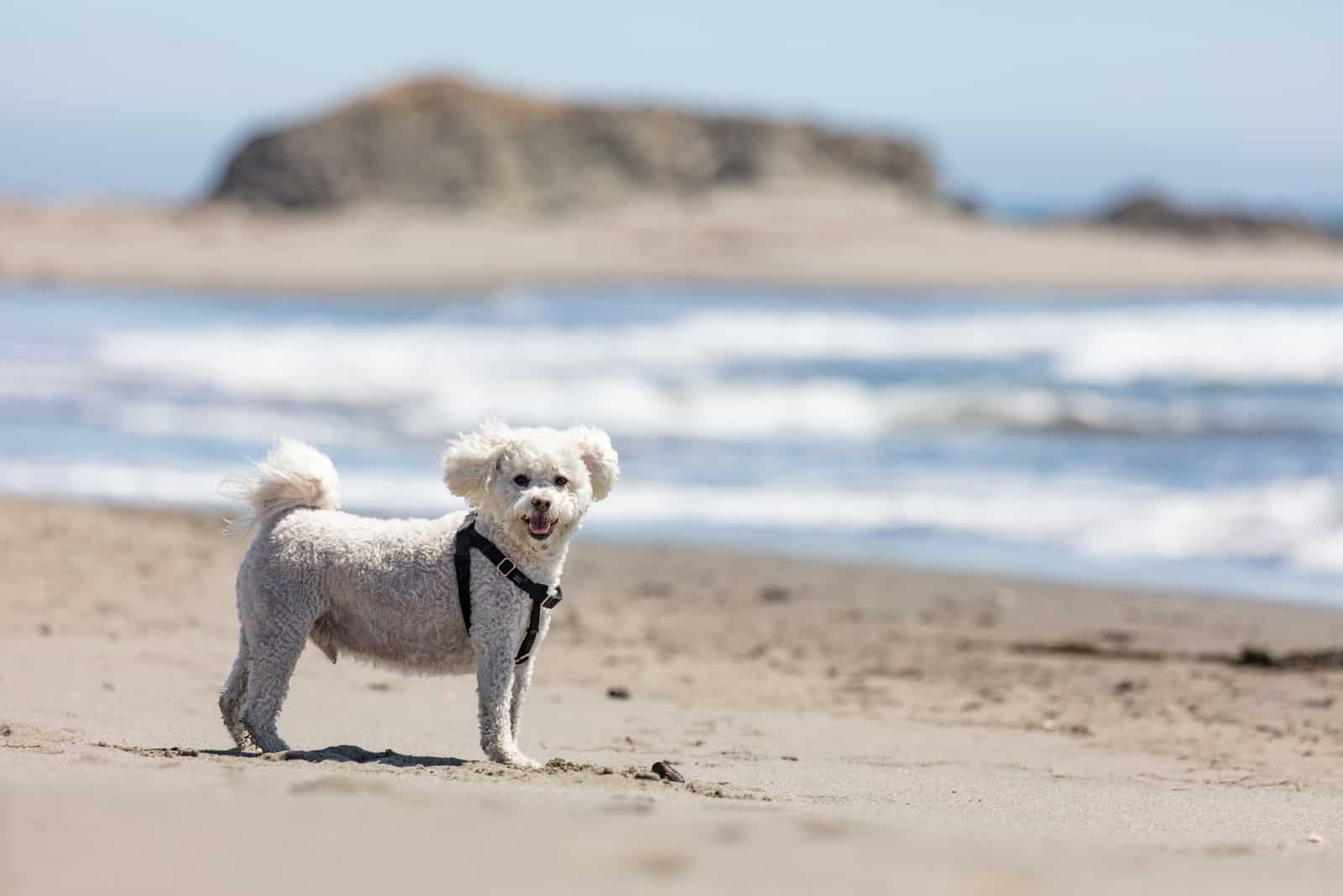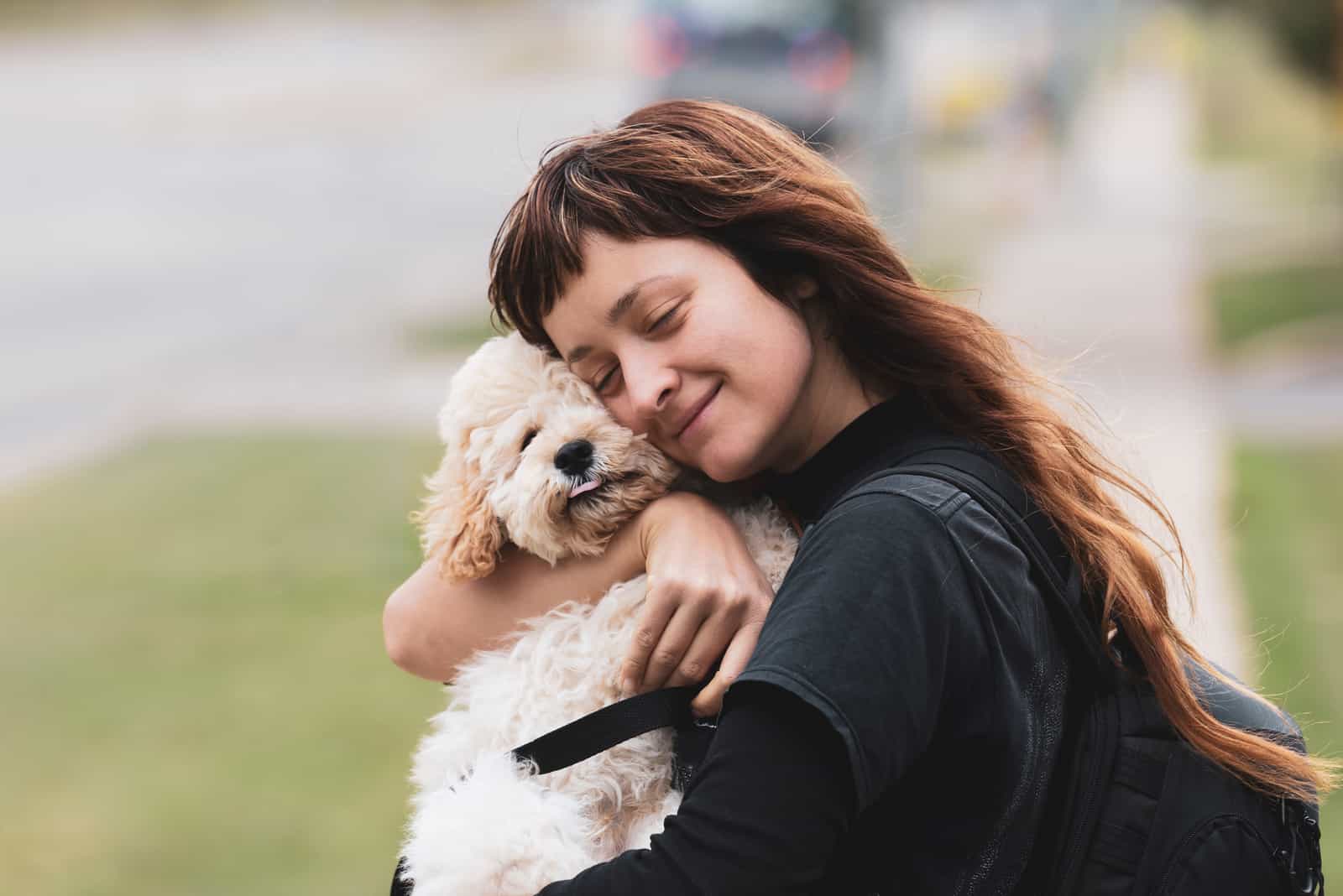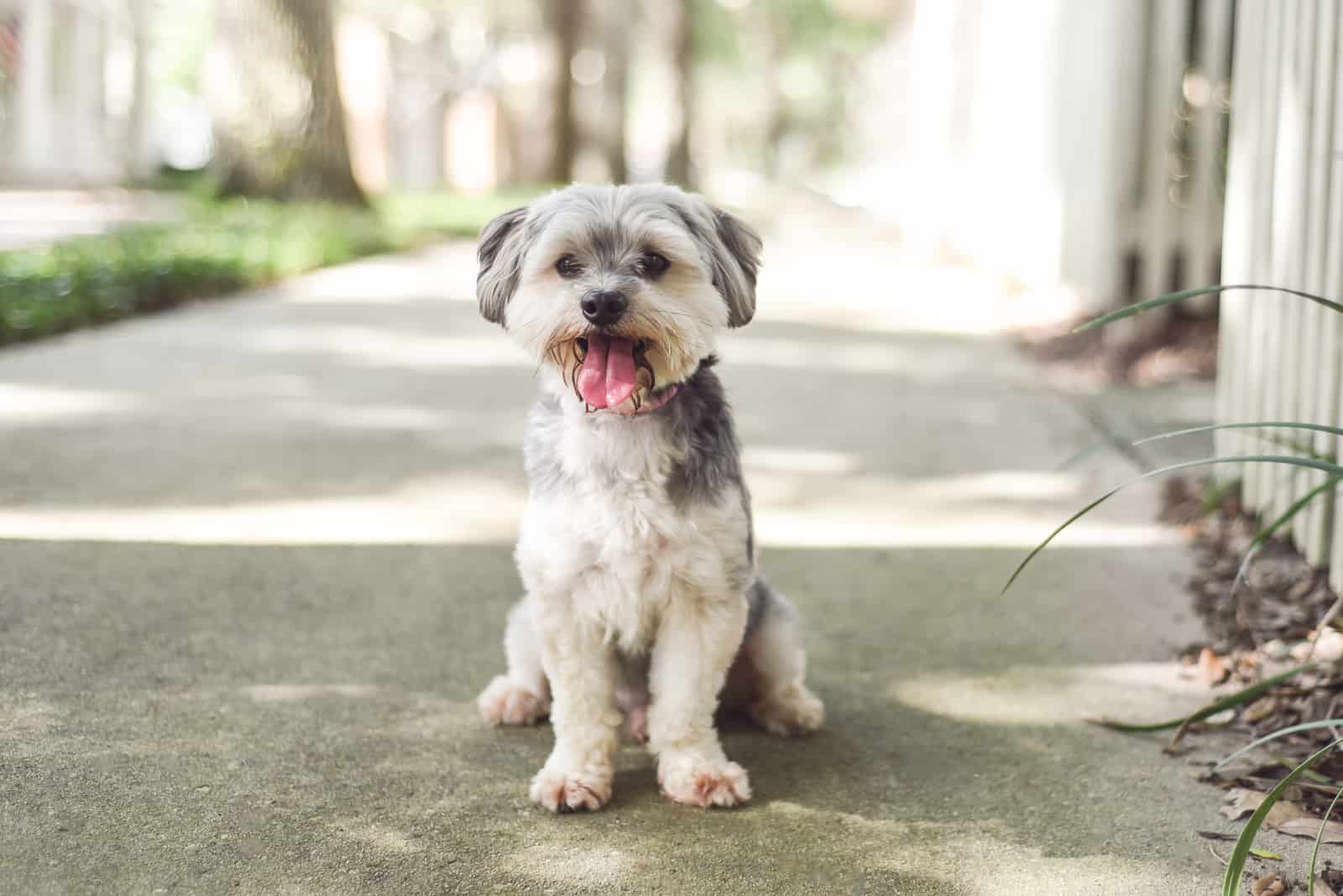The worst part of being a dog owner is knowing that one day you’ll have to let your pup go. We all want our beloved pets to live as long as possible, but knowing what to expect can truly help us deal with the painful fact of having to say goodbye.
Determining the average lifespan of a dog is especially difficult when you have a mixed breed. Most designer dogs haven’t been with us long enough for experts to learn how long these dogs will live. For example, understanding the Maltipoo lifespan isn’t as straightforward as it might seem at first glance.
The Maltipoo is the crossbreed of a Miniature Poodle and a Maltese. This apricot-colored dog is one of the most popular mixed breeds out there. It’s a lovable small dog that will act like everyone is his best friend! This adorable personality is what makes the Maltipoo a favorite dog breed for many canine lovers.
However, for most aspiring first-time owners, knowing the Maltipoo lifespan is among the determining traits that make dog owners decide for or against a breed.
So, how long does this small breed live?
If you want to learn more about the Maltipoo’s life expectancy, you’re in the right spot. We’ll explain all you need to know about the health of these pups and what you can do to increase the lifespan of your Maltipoo.
What Is The Lifespan Of A Maltipoo?

Compared to many other dogs, the Maltipoo has a pretty decent lifespan. This has a lot to do with its size; toy and mini canines tend to live longer than larger dogs.
Read More: Maltipoo Growth Chart
When we’re talking about the Maltipoo lifespan, we mean a death of natural causes. This includes any health problem or other type of bodily malfunction that occurs due to a dog’s aging process.
With that in mind, the average lifespan of a Maltipoo is between 12 and 15 years. Of course, plenty of Maltipoo dogs live longer than that. Some Maltipoos even reached 16 or 17 years of age!
On average, female Maltipoos live about a year longer than males, but many other factors contribute to that.
Considering that Maltese dogs live approximately 11–13 years, while Poodles live between 12 and 16 years, this long Maltipoo lifespan shouldn’t be a surprise.
Since the average purebred dog lifespan is 11 years, we can see that Maltipoos live at least a bit longer than most other breeds.
Keep in mind that since Maltipoos, as well as most other crossbreeds such as Labradoodles, Sheepadoodles, or Whoodles, aren’t recognized by the American Kennel Club (AKC), finding the official breed standard and health data is a bit challenging.
Teacup Maltipoo Lifespan

Since many teacup -size and smaller dogs have a somewhat shorter lifespan due to the tricky breeding process, you may think the same goes for Teacup Maltipoos, the crossbreed of a Maltese and a Toy Poodle.
Fortunately, Teacup Maltipoos have a decent lifespan, as well, as most will live around 12 years. It isn’t unheard of for these dogs to live even longer, just like their standard counterparts.
Once again, this is longer than the average dog’s lifespan, which is good news for any Teacup Maltipoo owner.
Maltipoo Puppy Causes Of Death

Before we continue talking about the Maltipoo lifespan, it’s important to go over one more fact: The death of Maltipoo puppies.
As sad as this is, sometimes puppies die as well. In fact, in some canines, breeding is so tricky that a significant part of the litter might pass away. Luckily, Maltipoos aren’t among them, but it still might happen that a Maltipoo puppy dies.
Here are some of the leading causes of death in Maltipoo puppies :
Infections
There are plenty of viral diseases that can strike a young puppy between the time when their mother’s immunity has subsided and before the pup has received all of its regular shots. These diseases include parvovirus, distemper, and leptospirosis.
Some bacterial infections and parasites can also endanger a puppy’s life. Because of this, you shouldn’t take your pup outside until he’s completed all of his vaccinations.
Congenital Diseases
Sometimes, puppies die from diseases that were present at the moment of their birth. Many genetic issues don’t wait until dogs are older to strike.
In Maltipoos and many other small breeds, a top concern is a condition called portosystemic shunts or liver shunts. This means that a puppy has an unusual blood vessel in or right next to its liver.
While this disease can be treated with surgery, this is not always an option with sensitive puppies, and they might die at just a few weeks of age.
Trauma
Unfortunately, the leading death of Maltipoo puppies is trauma.
This includes being hit by a vehicle, dropped, stepped on, etc. While rare, sometimes the parents might harm their puppy as well.
However, as this isn’t a natural cause of death, we won’t discuss this in any further detail.
What Affects The Maltipoo Lifespan?

Of course, just because there is an estimation on how long a breed will live, this doesn’t mean that all dogs will fall inside the spectrum. Many will live shorter or longer than predicted, and many factors contribute to that.
This includes the quality of life and nutrition. Poor diet and not enough exercise can make your pup get sick faster.
Genetic conditions and health problems might also negatively affect the Maltipoo lifespan.
Fortunately, Maltipoos are considered to be healthy dogs thanks to the hybrid vigor that all crossbreeds have.
Hybrid vigor means that a pup had a rather big gene pool from which its genes came from. This means lower chances of inheriting any bad recessive genes that carry genetic disorders. This makes crossbreeds much healthier dogs than their purebred parents.
Common Health Problems In Maltipoos

While Maltipoos are an overall healthy breed, they can still be affected by some health problems and diseases.
Here are some common health conditions that can greatly affect the Maltipoo lifespan.
White Shaker Syndrome
This serious health issue is common in smaller dog breeds. It causes full-body tremors and is common in both Maltipoo parent breeds – Maltese dogs and Miniature Poodles.
The biggest problem is that the disease’s sudden onset usually occurs between one and two years of age. Stress is the usual trigger.
While the exact cause is unknown, many experts believe it’s mediated by the dog’s immune system.
Fortunately, if the condition is diagnosed early, the prognosis is good. While some problems, such as seizures, nystagmus, or walking difficulties, might remain for life, the condition itself usually goes away after a week.
However, on many occasions, lifelong treatment is necessary, especially for dogs with any remaining issues.
Patellar Luxation
Just like hip dysplasia is common in larger dogs, patellar luxation is widespread among smaller dog breeds. In fact, around 7% of puppies of all breeds are diagnosed with it – but it’s prevalent in little dogs such as Havanese, Shih Tzus, Chihuahuas, and Miniature Poodles.
Patellar luxation is the medical term for a dislocated kneecap or a kneecap ( patella ) that tends to move (luxates) out of its normal location.
A dog that suffers from this condition will sometimes just start running on three legs, seemingly without a cause, before starting to walk normally again. This means that the kneecap has moved from its correct position before moving back into place once again.
When a kneecap moves out of place, the dog won’t be able to bear weight on the leg, although it might not show any other signs of pain. After a while, a pup might learn how to ‘kick’ the leg to the side, hyperextending the knee and snapping the kneecap back to where it should be.
There are several degrees of patellar luxation, ranging anywhere from mild luxation, in which a kneecap moves only after a certain force, over moderate luxation, in which the kneecap frequently moves, to severe luxation, in which the kneecap is dislocated most of the time.
Around 50% of dogs with patellar luxation have issues with both kneecaps, while the other 50% only have problems with one leg, no matter the side.
Legg Calve Perthes Disease
This is yet another common health problem in smaller dogs, such as the Maltipoo breed. Maltese dogs are especially prone to it, while it’s not as common in Poodles (but it’s still not rare).
This condition causes the degeneration of the femur – the ‘ball’ in the hip joint. Since this is a progressive disease, it can lead to hip collapse or even arthritis.
While the exact cause of this disease is unknown, it is believed that disrupted blood flow to the hip due to blood clots might be one of the reasons behind it. Whatever it is, the bone weakens and deteriorates, which leads to minor fractures.
Over time, scar tissue might develop as the body attempts to stabilize the bone. However, this scar tissue will only lead to arthritis.
The first sign of Legg Calve Perthes disease is limping on the affected leg and signs of pain. This starts gradually but then develops until your pooch can no longer bear weight on that particular leg.
While rare, this lameness can develop suddenly, together with extreme pain.
Legg Calve Perthes disease will almost always affect one rear leg. It’s very rare for both hips to be affected.
Mild cases can be treated with medication, including painkillers. The affected dog shouldn’t be let to become overweight, as this will only increase the problem.
In more serious cases, surgery is required to remove the head of the femur, allowing scar tissue to form. While this can cause some other complications, the dog won’t be in as much pain.
On rare occasions, a vet might use implants to replace a hip joint. However, this is a rare and expensive procedure, and most veterinarians would recommend using it as a last resort.
Even after the surgery, your Maltipoo would need physical therapy and medication.
Portosystemic Shunt (PSS)
While most common in puppies, a portosystemic shunt can also occur in older dogs.
A portosystemic shunt is an abnormally developed vessel that prevents the flow of blood from the dog’s intestine to its liver. As a result, the liver cannot absorb proteins, hormones, and toxins, allowing them to circulate throughout the body. This only leads to further liver deterioration.
While most shunts are congenital (a dog is born with it), some can be acquired secondarily, especially if there already is a liver problem present. In congenital shunts, there is usually only one abnormal vessel present. In secondary shunts, there may be more at once.
Congenital shunts can develop outside of the liver (extrahepatic) or inside of it (intrahepatic). Both are equally dangerous and prevent the liver from growing to normal size.
When the liver atrophies, this can lead to hepatic insufficiency. This, combined with the circulating proteins and toxins, can alter the function of the central nervous system of a Maltipoo puppy.
While the portosystemic shunt is quite common in the Maltese breed, it’s somewhat rare in Poodles, so there is a chance your Maltipoo won’t be affected by it.
Epilepsy
Epilepsy is one of the most common neurological conditions in canines. This is a medical term to describe repeated seizures that can be either single or occurring in clusters. Some may be unpredictable, while others occur at regular intervals.
The most common type of epilepsy is idiopathic epilepsy, which is an inherited condition. However, the exact cause of most epilepsies is unknown, as there are many things that might trigger it. This includes brain tumors, trauma, liver disease, kidney failure, or poisoning.
While your Maltipoo might be scared after a seizure, this isn’t a painful condition. Also, dogs won’t swallow their tongue during a seizure, so you shouldn’t put your hand or any foreign object inside of its mouth during an attack. You’ll only be risking injury to yourself or your pup.
A single seizure isn’t usually dangerous for dogs – however, cluster seizures or seizures lasting longer than a few minutes can cause problems or even death.
If your Maltipoo doesn’t have more than one seizure a month, he most likely wouldn’t be given any medication. However, when seizures continue, treatment is necessary.
Progressive Retinal Atrophy (PRA)
Progressive retinal atrophy is the degeneration of the retina, the light-sensitive cell layer at the back of the eye. The light enters the eyes through a lens and is then focused on the retina. From there, the signals are sent to the brain and creates a visual image.
The retina contains two types of photoreceptor cells – cone cells and rod cells, and the latter are more common in dogs.
Progressive retinal atrophy is an umbrella term for diseases that affect these photoreceptor cells, causing vision problems that can develop into blindness. Some forms of PRA are also called retinal dysplasia, but these two terms include the same types of diseases.
This disease is equally common in Maltese and Poodle parents. Since it isn’t painful, it may go unnoticed for months or even years until the pup develops night blindness. This will further develop into full blindness over time.
Fortunately, blindness isn’t as big a deal for dogs as it is for humans. Blind Matipoos can have a happy and long life without realizing they are any different from sighted dogs.
How Do You Increase The Lifespan Of The Maltipoo?

Luckily for all dog lovers, there is a lot that can be done to increase the Maltipoo lifespan. Here are a few of them!
Prevent Fatal Injuries
Trauma is a common cause of death in small dogs such as Maltipoos. Because of this, keeping them safe from injuries should be your top concern.
If you’re driving around with your Maltipoo in your vehicle, make sure he has a high-quality canine seat. You can find plenty of good products on Amazon or other similar websites.
Place signs on your door or gate that you have a dog on your property. While Maltipoos are far from dangerous dogs, this can, in fact, save them from being stomped on. All visitors will look around trying to see where the dog is, so they are bound to notice a small Maltipoo!
Don’t walk your Maltipoo without a leash, as he might be attacked by some smaller dog or run in front of a moving car.
If you have kids in your household, teach them how to behave around your pup. While children rarely mean harm, they can cause unintentional injuries if they don’t know how to handle an animal.
Proper socialization is also a must for this Maltese – Poodle mix, as good behavior can keep him safe from being attacked by other, not-so-patient, and undoubtedly larger dogs.
Choose High-Quality Dog Food
Proper nutrition is the key to a long life. This is something that goes for both dogs and their owners!
Maltipoos can have special dietary requirements, so be sure to consult with your vet if you think your pup needs a change of nutrition. Wet food is usually preferred over dry food, such as kibbles, but this is something you should talk about with a professional.
While treats are hard to resist, try giving them as positive reinforcement only. They can quickly make a dog overweight, and this is never a good idea.
If you cannot resist giving your dog treats more often than you should, try replacing store-bought ones with healthy alternatives from your kitchen, such as:
• Tuna
• Paprika
Make sure to consult your vet before making any changes to your pooch’s diet. Also, you can find useful information on this dog’s diet in our Maltipoo feeding chart.
Regular Vaccinations

Photo from: @maltipoosociety
Make sure your Maltipoo puppy is up to date with its vaccinations, and don’t take him outside until at least two weeks after his final shot.
If you live in an area with plenty of wild animals that could enter your property, talk to your vet and ensure he has a leptospirosis vaccine in case you need it. Also, consult with them about booster shots in case your pup ever needs them.
Have Regular Vet Check-Ups
Even though they are a healthy breed, Maltipoos should still have yearly vet visits. Senior dogs should visit a vet at least twice as often.
While going to the vet when your dog appears to be fine might seem like an unnecessary expense, this is the best way to ensure your Maltipoo is in top-notch condition and that he doesn’t have any underlying health problem that might end his life before its time.
Regular Exercise
Maltipoos aren’t high-energy dogs. However, they still need some daily exercise to stay healthy.
There’s nothing better for the Maltipoo lifespan than regular exercise and daily walks. This can help prevent most health concerns, especially cardiovascular and bone-related ones. Not to mention how this will improve a dog’s metabolism!
Buy From Reputable Breeders
Reputable breeders will conduct all the necessary DNA testing to ensure their puppies don’t suffer from any genetic disorders and problems. This is the best thing you can do to ensure you get yourself a healthy pup.
Maltipoo puppies aren’t the cheapest dogs you can find, but don’t try to look for the most affordable breeder! Chances are they aren’t checking their dogs’ genetic backgrounds, which can have terrible consequences.
A reputable breeder might even allow you to meet the parents of your dog, and they’ll let you know what generation your puppy is. All of this can help you find a pet that will stay with you for many years.
Read More: 7 Best Maltipoo Breeders In Florida You Can Trust
Maltipoo FAQ

How Long Can A Maltipoo Be Left Alone?
Maltipoos can be left alone for a short while. They might need some time to get used to you not being around all the time, but they can be okay on their own for a few hours.
However, as these dogs are very sociable, they can suffer from separation anxiety. This can result in destructive behavior.
Because of this, they aren’t recommended for people who spend a lot of time outside of the home or people who work a lot.
Maltipoos love being around their owners, and they’ll do all they can to spend as much time as possible by your side.
Are Maltipoos Hypoallergenic?
Most Poodle mix breeds are considered hypoallergenic, as Poodle genes keep dogs from shedding excessively. This is true for Maltipoos as well.
Maltipoos don’t shed a lot as they mostly have curly fur that prevents loose hair from flying out of their colorful coats. This also prevents dander from spreading around your house.
While there isn’t a truly hypoallergenic dog, and you might have an issue with any breed, Maltipoos come pretty close.
Just keep in mind that their silky fur requires regular visits to a professional groomer, as it’s prone to tangles and matting.
Are Maltipoos Good Family Pets?
Maltipoos are adorable dogs that love to cuddle and spend time with their owner. Because of this, they make amazing family pets, and they get along pretty well with kids.
However, as they are very small dogs, they are not recommended for very young children that don’t know how to handle dogs. They might injure a pup by accident.
At the same time, this breed is intelligent and easy to train and socialize. You won’t have any issues with obedience training or getting your Maltipoo puppy to get along with other pets inside the household!
Maltipoo Lifespan – Bottom Line

There are plenty of things that can affect the Maltipoo lifespan. This includes some genetic concerns, trauma, even the type of food you’re giving your pup or the breeder you’re getting him from!
However, Maltipoos are mostly healthy dogs that live between 12 and 15 years. This is more than most dogs will live, which is why they make excellent pets for people who are saddened by the fact dogs don’t live as long as we do.
With a bit of proper care and love, your Maltipoo can stay with you for many years! They aren’t difficult to keep and maintain, and they won’t cost you a lot in vet bills.
While there are still a few things you need to be mindful of, with Maltipoos, you’ll be sure to have a worry-free time with your beloved pup!
Read Next: Top Maltipoo And Teacup Maltipoo Breeders From USA!


